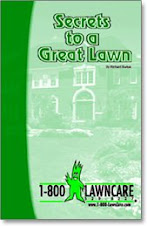In North Texas, rain has fallen more in the last six months than in the last three years. We've all seen the images of flooded areas and some have witnessed the weathers devastation first hand. Having been in a drought the last four years, the rain was a welcome sight, but too much of good thing can backfire. We've seen erosion, flooding, turf disease and above all weeds.
When ornamental turf grasses get water logged, some weeds start growing faster, stronger and in numbers we rarely see. One of those problem weeds is classified as a grassy weed known by most as Nutsedge. Nutsedges are water grasses, often seen in abundance in wet years, it flourishes with a voraciousness when it rains. Nutsedge is differentiated from other weeds in several ways. First, it spreads below the surface with what's called "Tubers" small nodule seed pods that travel laterally just below the surface, and germinate quickly as water puddles or saturates the turf, this attribute makes hand pulling the weed with satisfactory results near impossible. Secondly, it has a triangular stem, with narrow small waxy leaf blades, making applying herbicides difficult as the leaf blade is small and rigid, making saturation of herbicides difficult.
The picture above is that of Purple and Yellow Nutsedge, the most common of the sedge grasses in ornamental turf, these two grassy weeds can produce many seed tubers just below the surface, and be dormant for years without germinating, only to pop up as the yard becomes saturated. Rarely do we see this weed in lawns not well irrigated, and usually the healthier the lawn, the more apt you are to see this problem weed and no other.
If a lawn has not been maintained for sometime, not mowed, nutsedge will produce a seed head once the weed has grown to some height, which in turn can fall to the ground and spread the weed out even more. This is rare as most ornamental lawns are mowed frequently preventing the weed from producing seed, regardless, the tuber just below the surface can germinate and the weed can spread no matter how often the lawns mowed. The other problematic aspect of controlling nutsedge is the narrow leaf blade. Lawn Technicians often find the yard they're treating well mowed, the nutsedge hiding in the grass with little to no leaf surface to apply chemicals to kill it. However, if the tech can treat the yard before the most recent mowing, the weed presents a bigger target of leaf surface for chemicals to adhere to it.
Weather plays a huge part in lawn care, some weeds enjoy wet rainy patterns, while others flourish in hot, dry weather. This year nutsedge is the weed we've seen taking over in most lawns, and its industry wide as company's like Lawn Tech, try and kill the weed with some consistency. The chemicals we have in our arsenal work effectively at killing nutsedges, but the conditions must be right to get a total kill. Usually nutsedge can be controlled with several applications and diligence in applying the chemical if the tech can treat the yard prior to the most recent mowing event, effectively killing the weed.
If you've noticed this problem weed, don't feel bad, everyone seems to have it, and when we've had record rainfall, this little weed is guaranteed to come roaring back in big numbers. Call us today @ 972-346-2696 and we can schedule a time to come out and kill nutsedge, or you can visit our website @ lawntech.com.
Welcome to Lawn Talk.
Designed to answer any questions you have regarding fertilization, weed control and ornamental turf diseases. Be sure and scroll to the bottom of the page for helpful articles and past entries.
Subscribe to:
Post Comments (Atom)








No comments:
Post a Comment